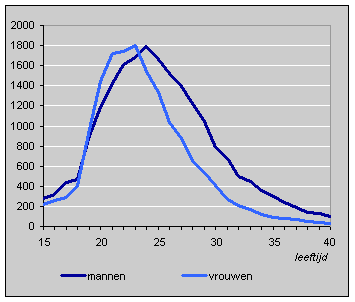Boomerang children

In 1999, 37,000 Dutch children and young adults aged 15 and older years returned to live with their parents. This figure is about a thousand higher than in 1998. These are unmarried children who had left the parental home at least one year previously. Children who return to their parents after a divorce are not included.
More men than women went back to their parents, and they were on average two years older than the women who returned, although men are also on average two years older when they leave home in the first place.
Children returning to live with their parents, 1999

There was a clear rise in the age group 20-22 years for women who returned to their parents in 1999 compared with 1998. The main reason for this was a rise in the number of women in that age group living independently. The total number of women in this age group did not change though. The number of 20 year-old women was only 1.5% higher on 1 January 1999 than on 1 January 1998, while the number living independently increased by 9%.
The increase in the number of young women living independently was probably caused by an announcement by the institute providing study grants that it was to start comparing address information supplied by students with that of the municipal population registers. This measure also resulted in a rise in the number of men living independently.
However, the number of men returning to their parents in 1999 did not increase, probably because they are less inclined to return to their parents when they have end a relationship or study.
Helma Schapendonk-Maas